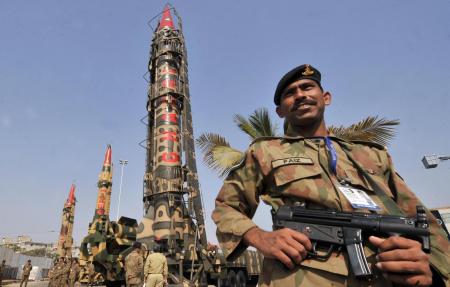Pakistan Has The World's Fastest Growing Nuclear Programme
Pakistan nuclear programme

NEW DELHI: A new report by the US-based Council for Foreign Relations titled, “Strategic Stability in the Second Nuclear Age” has concluded that Pakistan “ has the fastest-growing nuclear program in the world.”
“By 2020, it [Pakistan] could have a stockpile of fissile material that, if weaponized, could produce as many as two hundred nuclear devices,” the report notes.
It adds that South Asia is the region “most at risk of a breakdown in strategic stability due to an explosive mixture of unresolved territorial disputes, cross-border terrorism, and growing nuclear arsenals.” “Due to the security trilemma, the deterrence relationship between India and Pakistan is intertwined with that of China. This trilateral linkage increases the region’s susceptibility to outside shocks and amplifies the risk that regional developments will have far-reaching effects. Each of these dynamics is worrisome on its own, but the combination of them could be particularly destabilizing,” the report elaborates.
Asia, unlike the rest of the world where nuclear arsenal is shrinking, is experiencing a nuclear buildup. “China is increasing and diversifying its nuclear arsenal. Pakistan and India have been involved in a nuclear and missile arms race since 1998 that shows no signs of abating,” says the report.
China
China is estimated to have 250 nuclear weapons for delivery by a mix of medium-, intermediate-, and intercontinental-range ballistic missiles, SSBNs, and bombers.
TABLE 1: Chinese Nuclear Forces 2013 (CFR Report).
Pakistan
Pakistan, with the fastest growing nuclear weapon programme in the world, is believed to have enough fissile material to produce between 110 and 120 nuclear warheads. By 2020, Pakistan could have a fissile material stockpile sufficient to produce more than 200 nuclear weapons.
TABLE 2: Pakistani Nuclear Delivery Systems 2013 (CFR Report)
India
India is estimated to possess enough fissile material for between 90 and 110 nuclear weapons and is expanding its fissile material production capacity. India currently fields nuclear-capable aircraft and ballistic missiles and is developing longer-range ballistic missiles, including a version capable of carrying MIRVs; a ballistic missile that can be fired from a surface ship; ground-, air-, and sea-launched cruise missiles; and a nuclear-powered submarine capable of launching SLBs.
TABLE 3: Indian Nuclear Delivery Systems 2013 (CFR Report)
Link to the full report:



